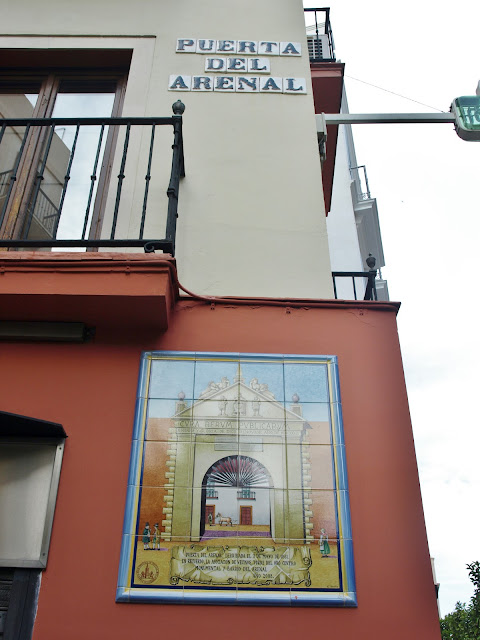En el edificio que hace esquina entre la Calle García de Vinuesa (antigua Calle de la Mar) y la Calle Castelar está situado este azulejo recordando el lugar exacto donde estaba situada una de las entradas de la ciudad cuando esta estaba amurallada.
La Puerta del Arenal (se tienen noticias de ella desde 1274), que era así como se le llamaba y hoy da nombre a este mismo lugar, era de origen almogárabe, reino musulmán que protegían la ciudad de las incursiones piratas y guerreras que provenían de las aguas del río Guadalquivir.
Posteriormente, en los siglos XVI y XVII fue restaurada y reconstruida para hacerla más alta y más ancha demoliendo los edificios adyacentes para alcanzar este fin, de hecho a ella hace referencia Arturo Pérez-Reverte en su libro "El oro del Rey" de la saga del Capitán Alatriste, ambientada en el reinado de Felipe IV.
El 3 de Mayo de 1861 fue derribada para siempre, no antes de ver pasar por su arco el oro y la plata de las Indias, la mercancía que llegaba de las Filipinas, de Japón y de las Indias Orientales o el trasiego de pescado que los marineros de Triana mantenían para abastecer a la ciudad.
Su aspecto es conocido gracias a distintos dibujos y grabados realizados en el tiempo, en especial al de Anton Van den Wyngaerde de 1567. Otro muy posterior de Bartolomé Tovar realizado en 1878 la representa con un frontón triangular superior, fruto de una reforma neoclásica. En la fachada interior figuraba la inscripción «CVRA REVM PVBLICARVM» y bajo ella «A HONRA Y GLORIA DE DIOS RENOVOSE AÑO DE MDCCXXXIV».
In the building that is in the corner between García de Vinuesa Street (the old Street of the Sea) and the Castelar Street is placed this tile remembering the exact place where one of the door was placed of the city when this one was walled.
The Door of the Arenal (Sandbank) (from 1274), has muslim origin. The Moslem kingdom that protected the city of the pirates and warriors incursions who were coming from the waters of the Guadalquivir.
Later, in the XVIth and XVIIth century it was restored and reconstructed to make it higher and broader demolishing the adjacent buildings to reach this end, in fact to her Arturo Perez-Reverte refers in his book "The gold of the King" of the saga of the Captain Alatriste, set in the reign of Philip IV.
On May 3, 1861 it was knocked down forever, not before seeing to pass for its arch the gold and the silver of the Indies, the goods that was coming from the Philippines, of Japan and of the East Indies or the decanting fish that the sailors of Triana were supporting to supply to the city.
Its aspect is known thanks to different drawings and engravings realized in the time, especially to that of Anton Van den Wyngaerde of 1567.
Very later Bartolomé Tovar realized in 1878 another one represents it with a triangular top fronton, fruit of a neoclassic reform.
In the interior front wall there was appearing the inscription "CVRA REVM PVBLICARVM" and under it "TO HONOR AND GOD'S GLORY RENOVOSE YEAR OF MDCCXXXIV".






